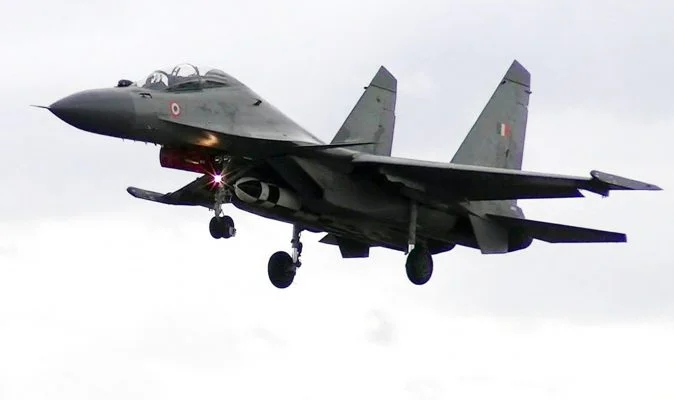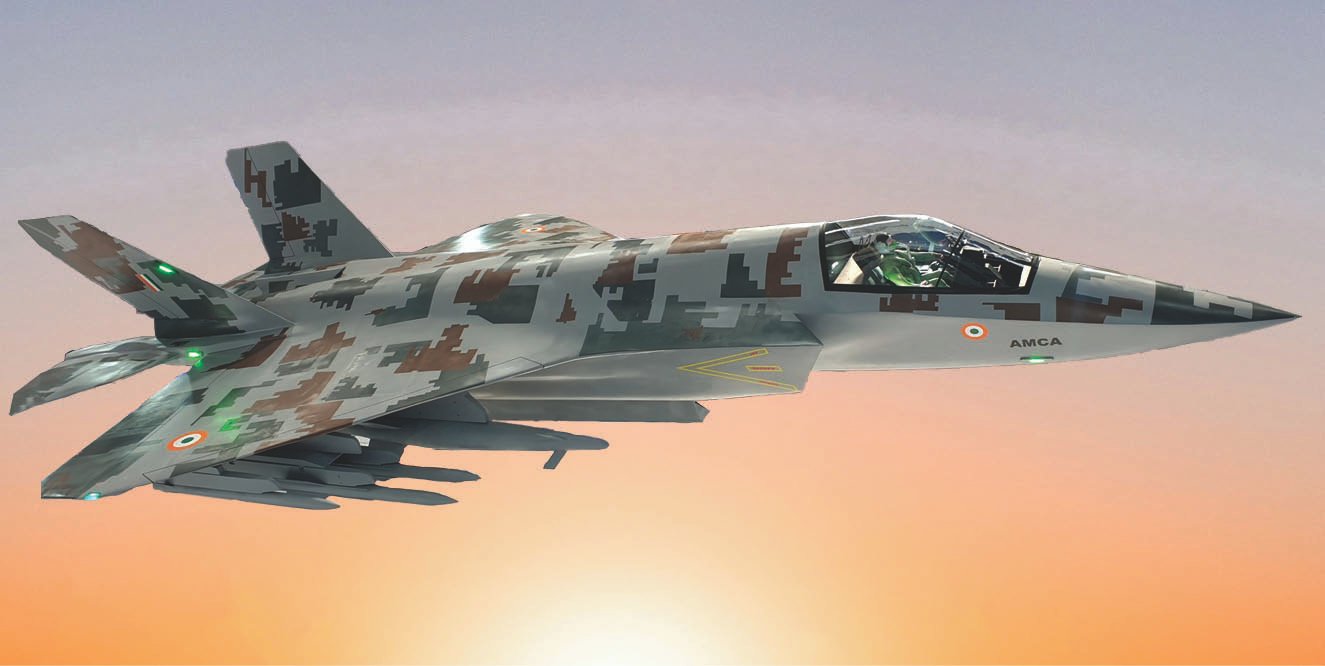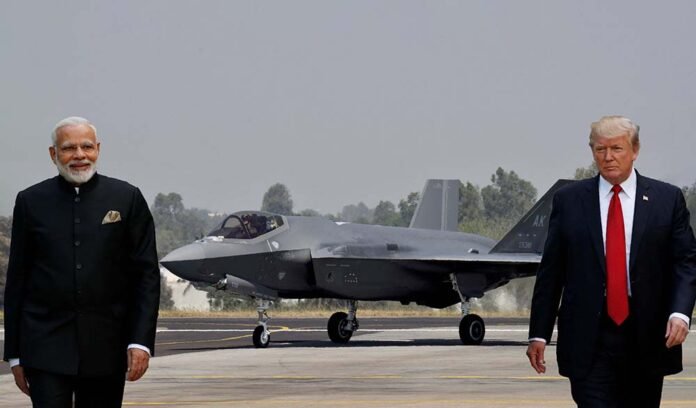In a major aviation development, US President Donald Trump has offered India two squadrons of the F-35 stealth fighter. This announcement has created a buzz in the aviation world, with many wondering if India should invest in the American-made fighter, priced at $110 million per unit, or look toward alternatives like the Russian Sukhoi Su-57, which is half the price. Alternatively, should India continue to develop its fifth-generation fighter, the Advanced Medium Combat Aircraft (AMCA)? The choice is not as simple as it may seem.
The Need for Stealth in the Indian Air Force
The Indian Air Force (IAF) is in urgent need of stealth capabilities to maintain an edge over its regional rivals. Particularly, China’s rapid development of the J-20 stealth fighter has posed a direct challenge. The J-20 is a straight copy of the F-35, with Chinese hackers stealing the blueprints of the American stealth fighter from Lockheed HQ.
Moreover, reports indicate that China plans to supply Pakistan with the export version of the J-31 fighter, potentially giving the Pakistan Air Force (PAF) its fifth-generation aircraft. Historically, the PAF was always the first to acquire the latest fighters thanks to its partnership with the US. So starting in the 1950s, it got the F-86 Sabres, F-104 Stafighters and the F-16 Falcons from the Americans, leaving the IAF to play catchup. It was only in 1987 that the IAF achieved air superiority by acquiring the Russian MiG-29 Fulcrum, which buzzed away the F-16s in the Kargil War. If Pakistan acquires the J-31, it will have a more modern aircraft for the first time in nearly 40 years.
In light of these developments, the IAF must act quickly to counter potential threats. However, the question remains: should it opt for the F-35, the Sukhoi Su-57, or focus on its own indigenous AMCA fighter?
The Case for the F-35
The primary allure of the F-35 lies in its stealth capabilities. However, it’s important to clarify that stealth is not an invisibility cloak; rather, it reduces an aircraft’s radar signature, making it harder to detect. That said, the F-35 still faces several significant challenges.
Fleet availability is the key to launching a successful air war. Basically it deals with the total number of aircraft that are fit for missions at any given time. The IAF’s frontline combat aircraft, the Sukhoi Su-30MKI has a fleet availability of just 60 per cent (compared to the Western average of 70-75 per cent for equivalent fighters). This means only around 180 of India’s 300 or so Sukhois can immediately take to the sky while the rest may be in various states of repair or servicing.
The F-35’s availability rate is abysmal. Overall fleet-wide monthly availability rates remain around 51 per cent, a condition that has existed with no significant improvement since October 2014, despite the increasing number of new aircraft, according to a Pentagon report.
Stealth comes with a price. On the F-35, most of the maintenance is on the ‘stealth’ coating, which has to be painstakingly re-applied after each flight. The Maryland-based Naval Air Systems Command says that F-35 fighters are expected to require between 41.75 and 50.1 maintenance man-hours per flight hour, or about three times as many as most fighter aircraft currently operated by Western air forces.
The Indian Air Force urgently needs stealth capabilities. China’s J-20 stealth fighters have posed a direct challenge and reports indicate that China plans to supply Pakistan with the export version of the J-31 fighter, the fifth-generation aircraft
Having to stay grounded for that long seriously compromises the number of sorties an Air Force can launch. “It is a ludicrous impediment to combat. You are sitting on the ground for 50 hours fiddling on the aircraft trying to make it stealthy when it’s not stealthy anyhow,” said aerospace engineer Pierre Sprey. Few people were qualified to speak about fighter aircraft as Sprey. He was the co-designer of the F-16 Falcon jet and the A-10 Warthog tank buster, two of the most successful aircraft in the USAF.
Left unsaid is the fact that 50 hours of maintenance is during ideal flying conditions. In actual combat when the F-35 will be put through the rigours of evasive manoeuvres and sustained high-speed flight, the wear and tear on the stealth coatings – plus the airframe – will surely be of a much greater scale.
Limited Payload
Additionally, the F-35’s weapon payload is relatively limited. Lower internal payload means the designers at Lockheed-Martin have signed the F-35’s death warrant. The aircraft carries just two large bombs and four small ones, and a maximum of four beyond visual range (BVR) air-to-air missiles (AAMs). The USAF claims the F-35’s advanced radar will see the enemy aircraft first and be able to take it out with one of its four long-range AAMs.
But BVR kills are still the stuff of fiction for fighter pilots because they are quite rare. In fact, the reliance on radar acquisition and AAMs can prove suicidal – as observed in the Vietnam War. Back then the USAF was so smitten with the concept of BVR combat that the first F-4 fighters were armed only with missiles. But after the Vietnamese Air Force shot them down by the bucket load, the Americans reintroduced cannons in the F-4.
In fact, Russia, which has the most varied range of BVR missiles in the world, arms its Sukhoi fighters with at least eight missiles for the reason that it takes several shots at a fast moving target to score a kill.
Another issue is with the F-35’s overall shape. “Most great aeroplanes are beautiful because you are trying to reduce drag,” Sprey said. “But here because of stealth, they had to make it very bulbous, very big as they had to carry the weapons inside because as soon as you carry the weapons outside they reflect radar. So this is a huge penalty to the performance of the aircraft which is now big and lumbering like a bomber.”
Is the F-35 Underpowered for India’s Needs?
The F-35 is a single-engine aircraft. The IAF prefers twin-engine aircraft for the reason that safety and maintenance are huge issues in India. At Aero India in Bengaluru earlier this month, the resident hawks at Yelahanka Air Force Station were seen fearlessly flying over the airfield even as the F-35, Su-57, Tejas and Surya Kiran aircraft were flying demos. While bird hits can quickly cause a tragedy, there is also the issue of the hot and dusty environment in the subcontinent that impacts engine performance. Manufacturers in the US and Europe do not have to deal with these factors when they are designing aircraft. So in case of trouble, a second engine guarantees that the pilot can safely land the aircraft rather than eject and lose an expensive aircraft.
Costly Affair
The flyaway cost of the F-35 is around $110 million today. This compares well with the Rafale which has a price tag of around $120 million. However, the real money is in maintenance. If you think the Russians are milking the IAF by charging exorbitant prices for spares and maintenance of Sukhois (that is, when they can find the spares), then the F-35 maintenance system could prove to be a nightmare.
Because the F-35 is basically a flying computer with massive lines of software bundled with advanced (albeit unproven) technologies, it would require a lot of maintenance by dedicated Lockheed air crews. Because some of the new technologies in the aircraft are a closely guarded secret, certain areas of the aircraft will be no-go areas for non-American maintenance crews.
For countries like India, with zero experience in stealth, it would mean either waiting for Lockheed crews to arrive onsite from the US, or shipping the aircraft back to the nearest Lockheed maintenance hub. Imagine this happening in the middle of a war. Perhaps this is the reason why several countries have pegged down the number of F-35 aircraft they will eventually buy, while Canada cancelled its contract altogether.
How Costs Could Impact India
First, let’s see how the US deals with the aerial component of warfare. The US has traditionally relied on massed waves of aircraft to bludgeon down the enemy. For instance, during both the 1991 and 2003 Gulf Wars, the Americans launched mass bombing raids (comprising over a thousand coalition aircraft) into Iraq that simply overwhelmed the country’s air defences. The Iraqi Air Force was unable to even get a good look at the enemy.
Another aspect of US air combat is to completely suppress enemy air defences before sending in attack aircraft. Enemy air space is virtually sanitised by the time American fighters and bombers arrive. Because USAF pilots rarely encounter enemy aircraft one-on-one, they do not intensively practise dogfighting tactics and evasive manoeuvres. American pilots prefer to attack from safe, standoff distances. Airborne Warning and Control Systems (AWACS) and satellites provide USAF commanders with a god’s eye of the battlefield.

Therefore, in a scenario where massive superiority in numbers prevails plus aerial intelligence is also available on a 24/7 basis, the limitations of a sub-par aircraft like the F-35 may not be exposed.
Secondly, the US will never get into a direct shooting war with a potent enemy such as Russia. Therefore, it can afford to put all its eggs in the F-35 basket.
Thirdly, the USAF, US Navy and Marine Corps will together buy 2,433 of these stealth fighters, which means at least 1,200 aircraft will be available for missions at all times at full programme maturity.
F-35’s weapon payload is limited. It is a single-engine aircraft while the IAF prefers twin-engine aircraft. It may not be ideal for air superiority, but if India acquires it as part of a geopolitical deal between Trump and Modi, it will offer some advantages
However, India cannot afford to buy such large numbers of the F-35s. Trump has offered two squadrons – or around 28 aircraft – to start with. Even allowing for 50 per cent fleet availability, it will leave the IAF with just 14 stealth aircraft at any given time.
The IAF is one of the few air forces in the world that conducts intense, year-round training. Benjamin Lambeth of the Carnegie Endowment for International Peace says the IAF trains for a “high intensity, high stakes” conflict. Keeping in mind the possibility of a two-front war, the IAF puts its pilots and aircraft through the wringer.
Mock air combat can involve hundreds of aircraft flying thousands of kilometres. During such a war game in 2013, IAF Sukhoi Su-30MKIs flew 1,800-km bombing missions from Chabua in Assam to the western front, with mid-air refuelling. In fact, IAF pilots are known to lead missions over 10 hours in their Sukhois.
But with the F-35, Indian pilots may well end up sitting around doing mock combat on simulators rather than actual flying. Winslow T. Wheeler, Director of the US’ Straus Military Reform Project, laid out the implications for air forces planning to induct the F-35: “The pilots will get worse as they’ll get much less training, which is more important than any technical issue. There’ll be far fewer pilots as the whole force will have to shrink, and you will basically have a showpiece aircraft that can’t do anything. It’s useless, it’s truly monumentally useless, it will ruin any air force that uses it.”
Stealth Bogey
Okay, let’s talk about stealth. The biggest problem with the F-35 is that its US designers are betting on stealth and long-range radar to compensate for its lack of speed and manoeuvrability. But stealth is not really all that it is cracked up to be; it is not the cloak of invisibility.
Plus, radars are getting better. Key radar advances are already deployed in the most advanced Russian surface-to-air missile systems, and existing IRST (infra-red scan and track) systems deployed on advanced Russian and European fighters are extending enemy detection ranges against radar-stealthy aircraft. Fighter radar pick-up capability of up to (46 km) is proposed against even ultra-stealthy aircraft like the F-22, coupled with IRST ability to identify Advanced Medium-Range Air-to-Air Missile firings and less infrared-stealthy aircraft at (92 km) or more.
At the same time, there is no such thing as one radar in a war. “There are lots of radars,” Sprey explained. “And you can’t be nose-on or dead-level to every radar in the theatre. There are always going to be radars that are going to be shining up (from below) or looking from above – they can all see you.”
AMCA: India’s Own Fifth-Generation Fighter
India’s ambition to develop its fifth-generation fighter, the AMCA, remains a key factor in the decision-making process. India has already made significant strides in developing the AMCA, which offers a unique opportunity to produce a fighter that caters specifically to India’s needs. The AMCA could potentially incorporate the best aspects of both the F-35 and Sukhoi Su-57, including stealth and manoeuvrability, while also being more cost-effective in the long term.

However, the AMCA is still in the development phase, and it may take several more years before it enters production. As such, India faces a difficult choice: delay its purchase of advanced stealth fighters in favour of developing the AMCA or acquire foreign fighters like the F-35 or Sukhoi Su-57 in the interim.
The Geopolitical Angle
The F-35 is all about networked warfare, with the aircraft sharing situational awareness with all the other F-35s in a theatre. In future, it will also have the ability to ‘talk’ to other non-stealthy aircraft and pass on data scooped up by its extremely long-range sensors. Theoretically, each F-35 is like a mini AWACS that will lead other non-stealthy aircraft into battle, thereby acting as a force multiplier. The induction of such an aircraft will translate into a huge learning opportunity for the IAF, which is currently moving into networked warfare.
India’s ambitious fifth-generation fighter, the AMCA, can potentially incorporate the best aspects of both the F-35 and Sukhoi Su-57, including stealth and manoeuvrability, while also being more cost-effective in the long term
Here’s a reality check about defence deals between governments. Major weapons purchases are never about the weapons alone. They are also about getting the seller to scratch your back. The IAF has always wanted a closer relationship with the USAF. Both air forces have conducted regular mock combat exercises since 2004. As New Delhi and Washington move closer geopolitically, closer integration with the US military is inevitable. As QUAD members, India and the US share intelligence on Chinese maritime activity in the Indo-Pacific.
The F-35 may not be the ideal air superiority fighter but if India acquires it as part of a geopolitical deal between Trump and Modi, it will offer some advantages. A) It will offset the J-31s when and if they enter service in Pakistan. B) It will be viewed as a symbol of the IAF’s commitment to 5th and 6th generations. C) It will help the IAF transition to the AMCA. The Americans can be persuaded to help to develop the AMCA in which the Russian aerospace experts are also participating. The AMCA can then offer some of the good aspects of the American F-35 and the less advanced but super-maneuverable Su-57
Media Hype
For a jet fighter facing numerous technical challenges despite years of development and operational capability, the F-35 has become a sensation in India. Even vague rumours that the US has offered it to India are enough to set off fireworks in the media. It happened first on July 22, 2007, and again in January 2018, with the Press Trust of India being the culprit on both occasions. Between these two instances of media-driven hype, there was Prime Minister Narendra Modi’s famous US 2014 visit during which several editors in New Delhi speculated that India was likely to sign an F-35 deal. So, tomorrow, if Vladimir Putin offers four squadrons of the Su-57, the same editors will tell you the Russian aircraft is the ultimate.
Rule of thumb – don’t believe everything the media tells you.
–The writer is a globally cited defence analyst based in New Zealand. The views expressed are of the writer and do not necessarily reflect the views of Raksha Anirveda






